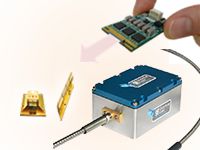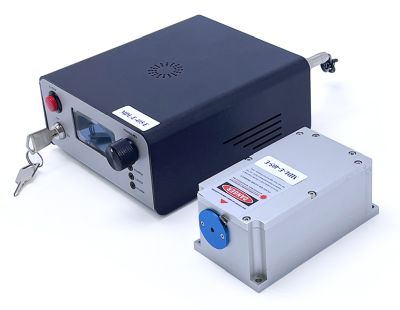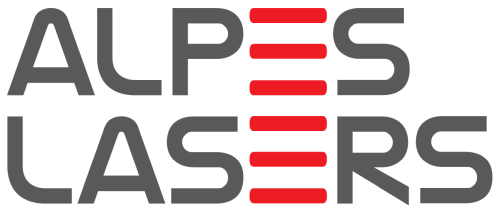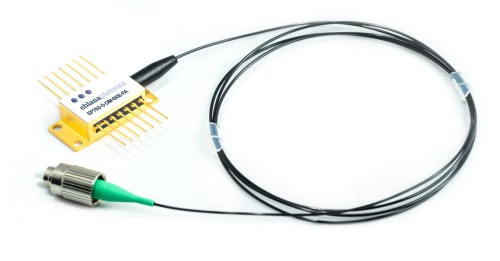diode lasers (original) (raw)
Definition: semiconductor laser devices based on laser diodes
Categories:  optoelectronics,
optoelectronics,  laser devices and laser physics
laser devices and laser physics
- solid-state lasers
- semiconductor lasers
* laser diodes
* diode lasers
* high-brightness laser diodes
* diode bars
* diode stacks
* vertical cavity surface-emitting lasers
* external-cavity diode lasers
* fiber-coupled diode lasers
* mode-locked diode lasers
* laser diode modules
* direct diode lasers
* (more topics)
* edge-emitting semiconductor lasers
* surface-emitting semiconductor lasers
* quantum cascade lasers
- semiconductor lasers
Related: laser diodeslaser diode modulessemiconductor laserslaser diode collimatorslaser diode drivers
Page views in 12 months: 1456
DOI: 10.61835/sie Cite the article: BibTex BibLaTex plain textHTML Link to this page! LinkedIn
Content quality and neutrality are maintained according to our editorial policy.
📦 For purchasing diode lasers, use the RP Photonics Buyer's Guide — an expert-curated directory for finding all relevant suppliers, which also offers advanced purchasing assistance.
What are Diode Lasers?
Diode lasers are semiconductor laser devices based on laser diodes. Although the terms diode laser and laser diode are often used with the same meaning, it is appropriate to distinguish the terms: the diode laser is a laser device, which may sometimes consist only of a single laser diode, but may also contain additional items:
- The laser diode may be combined with an external optical resonator, so that the device is an external-cavity diode laser.
- A diode laser device may contain multiple laser diodes with some optics for beam combining (for example spectral beam combining).
- A diode laser may also include additional optics outside the laser resonator, such as a beam collimator or a beam shaper, means for coupling the light to an optical fiber (→ fiber-coupled diode lasers or pigtailed diode lasers), or means to provide optical feedback, e.g. to reduce the emission linewidth.
- In some cases, a device for nonlinear frequency conversion is also included.
- A diode laser may be provided with a housing, which may also contain means for temperature stabilization of the laser diode and a laser diode driver. See also the article on laser diode modules.
Applications of diode lasers are mentioned in the article on laser diodes.
Frequently Asked Questions
What is the difference between a diode laser and a laser diode?
A laser diode is the core semiconductor component that generates laser light. A diode laser is often understood to be the complete laser device, which contains a laser diode but often also includes additional components like optics, electronics for driving and temperature control, and a housing.
What additional components can a diode laser include?
Besides the laser diode itself, a diode laser can include optics for beam collimating or shaping, components for fiber coupling, an external optical resonator, a laser diode driver, and temperature stabilization equipment, all within a protective housing.
What is an external-cavity diode laser?
An external-cavity diode laser is a type of diode laser where the laser diode is combined with an external optical resonator, which can be used, for example, to reduce the emission linewidth.
Suppliers
Sponsored content: The RP Photonics Buyer's Guide contains 107 suppliers for diode lasers. Among them:
⚙ hardware
Lumibird manufactures a wide range of laser diodes and laser diode modules. Our offering includes QCW diode stacks, CW laser diode modules, fiber coupled QCW diode stacks, short pulse laser diode illuminators, as well as high brightness diode source, IALDA, and pulsed power supply drivers for QCW diodes.
⚙ hardware
CSRayzer provides diode laser modules in butterfly package or TO-CAN package, operating in various wavelength bands. They include DFB laser diodes, SOA laser module, SLED, and pump LDs.
⚙ hardware
HÜBNER Photonics offers a range of diode lasers designed for applications requiring rapid power modulation and precision. Key features include:
- Fully integrated electronics for quick power adjustments with a rise time of less than 2.5 ns
- Emission wavelengths from 375 nm to 975 nm
- Available with free-space or fiber-coupled outputs
- Output power ranging from 50 mW to 400 mW
These lasers are suitable for use in scientific, industrial, and medical applications where fast response times and reliable wavelength precision are critical. For more details, visit the HÜBNER Photonics website.
⚙ hardware
Diode lasers combine plug-and-play operation, compact form factor and maximum performance. TOPTICA offers single-mode diode lasers, multi-color lasers, single-frequency lasers, and tunable diode lasers for demanding applications in biophotonics, industrial metrology and quantum technology. TOPTICA provides the widest wavelength coverage of diode lasers on the market (190 — 4000 nm).
The CLS — Ultra-Stable Clock Laser System — is a highly stable clock laser designed for quantum computing and optical clocks. Featuring sub-Hz linewidth via stabilization to ultra-low expansion (ULE) cavities, it ensures exceptional frequency stability for high-fidelity qubit control and precise optical clock transitions. Available at key wavelengths for Yb, Sr, Ca+, Ba+, and more.
The CTL — Continuously Tunable Laser — is the ultimate choice when looking for a laser that is widely and continuously tunable without any mode-hops. The CTL delivers wide mode-hop-free tuning up to 130 nm, available in wavelengths from 750 nm to 1750 nm. High resolution down to kHz level. Low noise and drift with a linewidth below 1 kHz for precise measurements at the quantum limit. User-friendly control panel and remote operation.
⚙ hardware
CNI offers a wide wavelength range of diode lasers with wavelengths from 375 nm to 1.9 μm, including TEM00 mode diode lasers, multi-line diode lasers, wavelength-tunable diode lasers, narrow linewidth lasers, long coherent diode lasers and others. They are all widely used in many scientific and industrial applications.
⚙ hardware
Sheaumann Laser offers a wide range of laser diodes, ranging from low-power single-mode emitters to multimode high-power lasers. Many different packaging options (with free-space output or fiber-coupled) are available. Emission wavelengths range from 785 nm to 1710 nm.
⚙ hardware
Serving North America, RPMC Lasers offers semiconductor laser diodes from UV (375 nm) to LWIR (17 µm) with the widest wavelength and package range, from mW TO-cans to kW fiber-coupled turnkey systems, covering components to subsystems.
Our diodes feature free-space or fiber-coupled outputs with connector/fiber options, multimode, single mode, polarized, low noise, stabilized, SLM, narrow linewidth, and single-frequency configs.
Tailored solutions from wafers and chips to OEM and turnkey systems, including single unit, ultra-compact, flexible multi-wavelength combiners with up to 4 diode laser wavelengths, USB-powered, for lightweight, handheld and portable applications or even for lab use.
Let RPMC help you find the right laser today!
⚙ hardware
SHIPS TODAY: AeroDIODE offers fiber-coupled laser diodes between 520 nm and 1650 nm as stock items or associated with a CW or pulsed laser diode driver. They are compatible with our high speed nanosecond pulsed drivers or high power CW drivers (with air cooling) for the multimode high power laser diode versions. The single mode laser diodes (either Fabry–Pérot laser diode or DFB laser diode) can reach high power in nanosecond pulse regime up to 400 mW. Most turn-key diode & driver solutions are optimized for single-shot to CW performances with pulse width lengths down to 1 ns. The laser diode precision pulses are generated internally by an on-board pulse generator, or on demand from an external TTL signal. Many multimode versions are available with CW emission up to 450 W in a 200-µm core multimode fiber or up to 250 W in a 135-µm core fiber or 160 W in a 105 µm core fiber.
See also our tutorial on fiber-coupled laser diodes.
⚙ hardware
Alpes Lasers manufactures laser diodes emitting at wavelengths from 1.45 to 2.15 μm with powers up to 50 mW. They are offered either as chip-on-carrier or encapsulated in a low power TO-66 package with collimated or divergent free-space beam output.
⚙ hardware
The Lumics diode lasers are ideal for OEM integrators developing state-of-the-art end-user laser systems, featuring single emitters with exceptional longevity. Lumics provides single-mode 14-pin BTF lasers for high-precision industrial applications, along with multi-mode diode laser modules available in various sizes, customizable to meet specific customer requirements. Users can specify wavelengths, power levels, and fiber core diameters to ensure the perfect diode laser match for their applications.
⚙ hardware
QPC Lasers full vertical integration from epitaxy through packaging allows us to offer standard and custom diode solutions in packages ranging from C-mounts to complete OEM light engines that provide performance without compromise.
⚙ hardware
The D2-200 laser module features an advanced Virtual Point Source (VPS) Distributed Bragg Reflector (DBR) diode laser. This new design uses a proprietary lensing system to reduce astigmatism, matching the divergence in the fast axis to that of the slow axis. The D2-200 employs two stages of temperature control and incorporates optical isolation for dependable long-term, mode hop-free operation.
⚙ hardware
Eblana Photonics' core product offerings are based on our patented Discrete-Mode (DFB like) manufacturing technology, which delivers industry leading performance with fully scalable, consistent production and integration capability.
Eblana’s products are used extensively for trace gas sensing and environmental monitoring in the near- and mid-IR.
In addition, the inherent low linewidth performance of the DM platform in comparison to typical DFB lasers is uniquely suited to distributed fibre sensing and LIDAR applications, as well as scientific and metrology projects.
Questions and Comments from Users
Here you can submit questions and comments. As far as they get accepted by the author, they will appear above this paragraph together with the author’s answer. The author will decide on acceptance based on certain criteria. Essentially, the issue must be of sufficiently broad interest.
Please do not enter personal data here. (See also our privacy declaration.) If you wish to receive personal feedback or consultancy from the author, please contact him, e.g. via e-mail.
By submitting the information, you give your consent to the potential publication of your inputs on our website according to our rules. (If you later retract your consent, we will delete those inputs.) As your inputs are first reviewed by the author, they may be published with some delay.
























